
More ethical than zoos, sanctuaries offer a chance to see animals in more natural and comfortable surroundings. They also make a great stop on a travelling trip and some rescue centres have even been founded by former travellers. Here are ten inspirational not-for-profit animal sanctuaries that promise an educational, interesting and uplifting visit. Many of these centres are also actively seeking volunteers, which might be an option for those looking for a more rewarding travel experience.
Lone Pine Koala Sanctuary, Brisbane, Australia
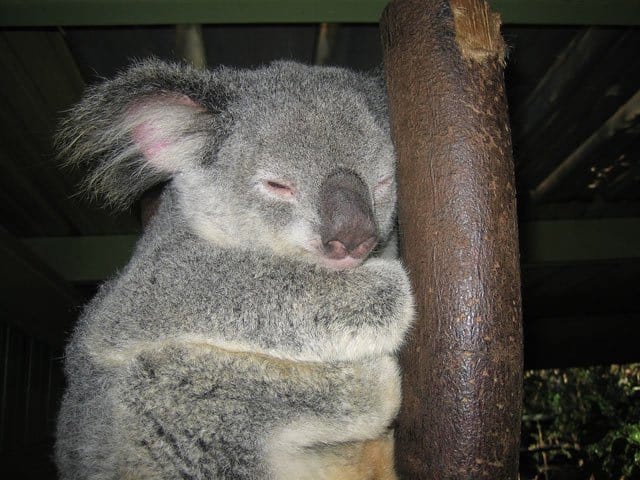 Photo
PhotoFounded in 1927, the Lone Pine sanctuary, Brisbane is the world’s oldest and largest Koala rescue centre. It’s also one of the very few places where you can hold a koala for a fee. A beautiful natural woodland reserve, the popular sanctuary generously offers a home to other animals including kangaroos, native Australian birds and platypus. You’ll also probably be surprised to see how fast the koalas move when the gum tree leaves are brought out at lunchtime.
Chengdu Moonbear Rescue Centre, China
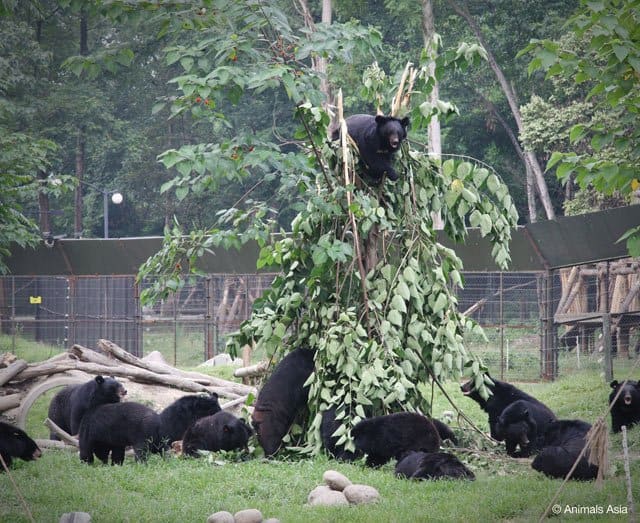
UK ex-pat Jill Robinson MBE founded the Animals Asia Foundation when she discovered how thousands of Asiatic black bears were being raised in factory farm conditions on Chinese bear bile farms (the bile is sold for use in traditional medicines). After years of tireless campaigning, the rescue centre was established in 2000 following an unprecedented agreement with the Chinese authorities to release 500 farmed bears. The sanctuary is open to the public and visitors travel for miles to see the bears experience freedom after spending decades in tiny crush cages.
Sepilok orangutan sanctuary, Borneo
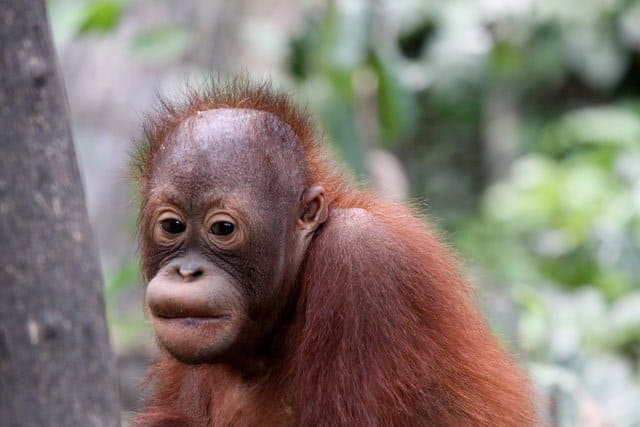 Photo
PhotoOnly a few travellers leave Borneo without visiting the famous Sepolik Rehabilitation Centre and when seeing photos of the impossibly cute residents it’s easy to see why. The sanctuary was founded in 1964 to rehabilitate orphaned orangutans which were mainly victims of the illegal pet trade and logging industry. The large virgin rainforest reserve is home to around 60 to 80 orangutans and they are trained to survive in the wild again and released as soon as they are ready. Visitors are welcomed to the centre but handling of the animals is strictly forbidden. A good tip is to time your visit around feeding time.
Boon Lott’s Elephant Sanctuary (BLES), Thailand

BLES located in Sukhothai, Northern Thailand was founded by English animal lover Katherine Connor after she travelled across Asia. During her time spent volunteering at a Thai elephant hospital she formed a very strong bond with a premature baby elephant. Instead of finishing her travels she decided to stay in Thailand to rescue her new friend from being sold to a notorious animal tourist show. After the elephant sadly passed away Katherine sold her possessions in England and with the help of her now husband (a Thai elephant handler) set up Boon Lott’s Elephant Sanctuary in his memory. All the elephants at Boon Lott have been rescued from abuse or mistreatment and visitors enjoy a chance to interact with the elephants in a peaceful and secluded location. Staying guests are asked to be involved in all aspects of sanctuary life ranging from collecting food from the jungle to repairing pens.
Noah’s Ark, Georgia, USA
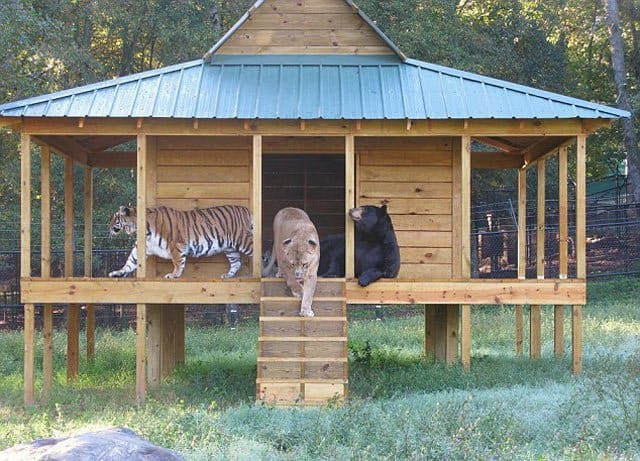
Noah’s Ark is a unique facility located in the US state of Georgia. It provides a home for abused, unwanted and orphaned children as well as animals. The centre is run entirely on donations and is open to the public. Guests arrive to visit the children and see the collection of over a thousand animals ranging from the very large and exotic to the very small and domesticated. Three of their furry resident’s have also made worldwide news. Baloo the bear, Leo the lion and Shere Khan the tiger have formed an unlikely and unusually strong bond after being rescued in a drug’s raid when they were just 2 months old. The predators (who would be enemies if they were ever to meet in the wild) are housed together and curious visitors travel from all over the US to see their affectionate friendship first hand.
Animal Kingdom, Philippines
 Photo
PhotoThe Animal Kingdom Foundation has a centre based in the Philippines which rescues dogs from the meat trade and a pretty gruesome fate. The charity was formed after a month long surveillance by animal advocates Greg S. Quimpo and Veterinarian Samaniego and they now work to fight against the illegal meat trade after realising thousands of dogs in the Philippines get caught up in it every day. They set up a no-profit, no-kill dog shelter dedicated to saving abandoned, neglected, abused and slaughter-bound dogs. They welcome animal loving visitors and the dogs are also available for adoption to good homes.
The Donkey Sanctuary, Devon, UK

The Sidmouth donkey sanctuary is an English national treasure and a popular family day out. It was founded by Dr Elisabeth Svendsen MBE when her donkey enthusiasm turned into a full blown rescue centre when she saw some ill treated donkeys at nearby Exeter market. Slade House Farm was purchased to house her fast growing family of four legged friends and since then 12,500 donkeys have passed through the sanctuary’s doors. Admission is free and many people come to see the previously neglected or abused donkey’s living happily in the picturesque Devonshire countryside.
The Vervet Monkey Foundation, South Africa
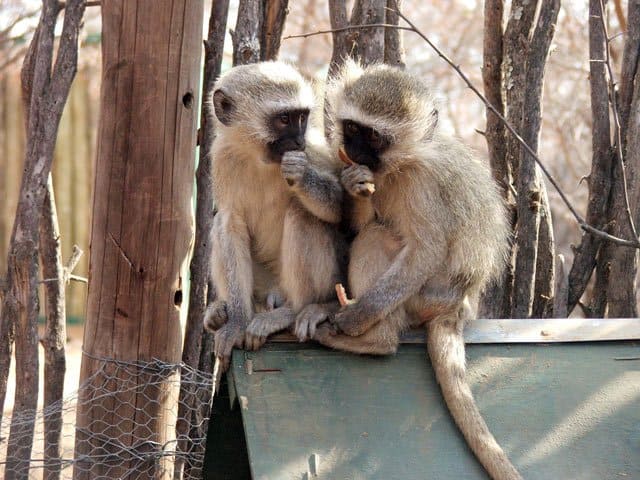 Photo
PhotoThe Vervet Monkey Foundation in Tzaneen, South Africa is home to nearly 700 orphaned, injured, ex-laboratory or unwanted pet monkeys. The sanctuary (established in 1993) is a 23-hectare rescue, educational and rehabilitation centre as well as being a popular tourist attraction. Volunteers are welcomed from all over the world and accommodation and plenty of Vervet monkey interaction is offered in return for help with everyday activities.
Agra Bear Rescue Facility, North India
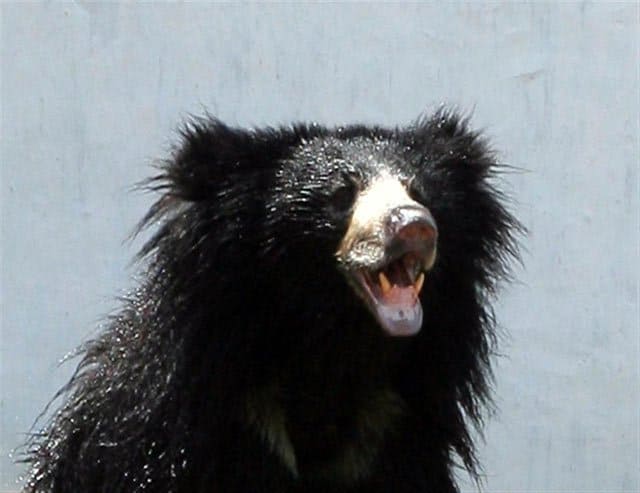
Two major animal charities helped fund a sanctuary for ex dancing bears in Agra, North India which is located just a few kilometres north of the famous Taj Mahal. The initiative was such a success that by the end of 2009 many of the dancing bears forced to dance on the streets of India for entertainment had been rescued. After their harsh and often brutal treatment the bears recover in large enclosures complete with freshwater bathing pools, climbing frames and other tools of environmental enrichment. Visitors are welcomed by appointment and guests speak of the enjoyment of seeing the naturally playful bears in their new comfortable surroundings.
The Best Friends Animal Sanctuary, Utah, USA
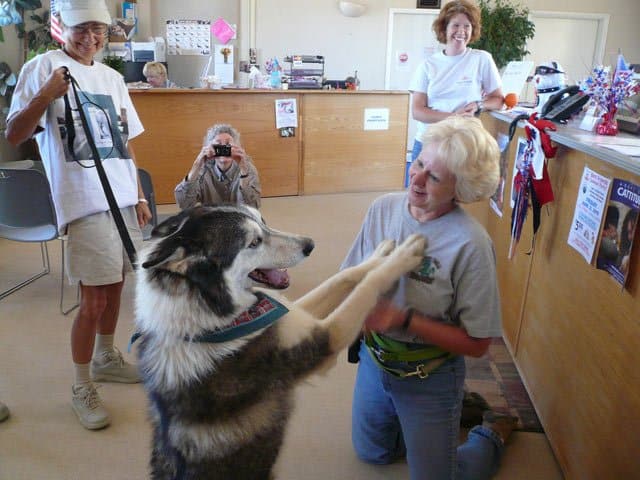 Photo
PhotoThe Best Friends Animal Sanctuary is located in 33,000 acres of exceptionally beautiful Utah landscape. One of America’s best known animal welfare groups, it was founded in the late 1980′s as an alternative to the ‘kill’ shelters in the US. The sanctuary now houses 1,700 displaced, homeless or unwanted domestic animals ranging from dogs to pot-bellied pigs. Best Friends is also very popular with visitors and volunteers who can’t seem to get enough of the great scenery and interaction with its often adorable residents.
 For as long as humans and animals have co-existed, our wild
counterparts have fascinated and amazed us. The original "zoo" concept
has undergone a number of great changes over the last few decades, and
today the focus is more on animal conservation, research and
appreciation. This month we decided to count down the Top 10 Zoos, with
our own focus being on facilities that we think put the animals first.
For as long as humans and animals have co-existed, our wild
counterparts have fascinated and amazed us. The original "zoo" concept
has undergone a number of great changes over the last few decades, and
today the focus is more on animal conservation, research and
appreciation. This month we decided to count down the Top 10 Zoos, with
our own focus being on facilities that we think put the animals first.Best Traditional 'Zoo'
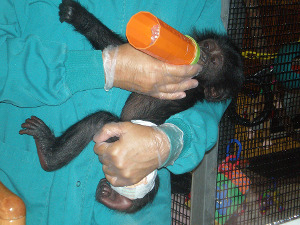 San Diego Zoo
San Diego ZooLocated in Balboa Park - one of the most stunning public parks in the United States - the San Diego Zoo is set on 40 hectares of prime California land. It is home to 650 species of rare and endangered animals, as well as 70,000 exotic plants, making it a serious winner for school trips, family outings and first date venues. This multiple award winning facility (for its conservation programs and recycling efforts among others) is exactly what you'd expect from a major American tourist attraction: it's friendly, efficient, clean and full of the biggest and best animals from around the world. From bears to zebras, rare birds, primates and reptiles. In addition to the park is the San Diego Institute for Conservation Research and the San Diego Safari Park - a wildlife sanctuary that is home to one of the country's most renowned botanical collections, as well as thousands of animals.
For more information about their research institute and visiting the zoo, log on to www.sandiegozoo.org
Best For Big Cats
Shamwari Game Reserve, South AfricaThe King of the Jungle finds himself at the top of almost every tourist's To-Do list, but no one wants to see the most respected animal in the world sitting a rusty cage, looking sad-faced and bored. Enter Shamwari Game Reserve - the best kind of zoo you can visit. Located in a remote corner of the beautiful Eastern Cape province, the reserve offers a personal encounter with Africa's Big 5 in their natural habitat without sacrificing safety or authenticity. The reserve offers drives "in modern open game viewing vehicles that have been specially converted to maximise comfort and viewing potential." They assure that "your personal game ranger will provide insightful and valuable information about the fauna and flora." For an even closer look, you can opt for a guided walk, which is basically as close as you can get to the animals without camping in the wild.
Shamwari Game Reserve also works together with the Born Free Foundation (UK), which aims at "providing long term humane care for rescued African cats that have been subjected to inhumane conditions internationally as well as to provide an education resource for visitors, school children and students."
For more information about the reserve, booking and their conservation work, check out www.shamwari.com.
Best For Sea Life
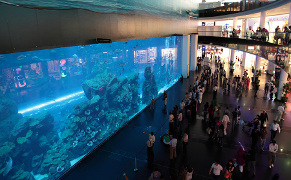 Dubai Aquarium And Underwater Zoo
Dubai Aquarium And Underwater ZooDubai is fast becoming the new Las Vegas with outstanding features like the Dubai Mall - which boasts a ski slope, a waterfall and the highly impressive Aquarium and Underwater Zoo. One of the city's Guinness World Record holding features is the 32.88 by 8.2 metre acrylic viewing panel at the aquarium. This giant window offers visitors a peek into the lives of over 30,000 living marine animals - including sharks and rays. The nearby underwater zoo includes a rainforest and a living ocean display, which takes you into the home of piranhas, otters and other exotic animals.
For more information visit www.thedubaiaquarium.com
Most Enduring Animal Sanctuary
The Donkey Sanctuary, Sidmouth, DevonThere couldn't be a more picturesque, dignified or relaxing place for aging donkeys - previously abused and neglected - to live out their days. The story behind the Donkey Sanctuary is almost like a Doctor Doolittle plotline - it is the brainchild of Dr Elisabeth Svendsen MBE, a kindhearted donkey lover from Yorkshire, who turned a bad experience at the Exeter market into the gorgeous facility in Devon that stands today. Thousands of donkeys have found a loving home at the good doctor's farm, where visitors are welcome to meet and pet these enduring characters. The sanctuary is open 365 days a year (except for the Hayloft café that closes during the first two weeks of January). From nine in the morning till dusk, the sanctuary is a free to all. It's an amazing family venue (kids love it) and the onsite café serves great food.
For more information about the sanctuary, whether you intend to visit or wish to assist in making a donation, please visit www.thedonkeysanctuary.org.uk/
Best For Birds
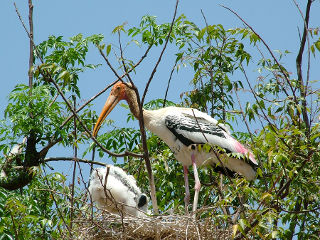 Keoladeo National Park, India
Keoladeo National Park, IndiaThe Keoladeo National Park is internationally touted as a bird watcher's Mecca. It's repeatedly described as 'a birder's paradise' in reviews by visitors and experts who are wowed by the magic of this UNESCO World Heritage Site. Close to 400 bird species live and pass through the sanctuary during the year, making every season exciting for a new reason.
Look Out For: Painted Storks, Great Egret and Siberian Cranes.
For more information visit www.keoladeonationalpark.com
Most Progressive Zoo
Edinburgh ZooThe Royal Zoological Society's work at Edinburgh Zoo has been applauded for the research and conservation conducted there, as well as the immense expense and effort that has gone towards making animal enclosures that are comfortable, natural and as eco-friendly as possible. Sir David Attenborough was even quoted as saying, "The Royal Zoological Society has shown not what zoos can be, but what they should be" - a massive thumbs up from the Morgan Freeman of the natural world. The zoo offers a massive range of animal viewing and young children will be especially excited by the gorgeous pandas and primates.
We do understand that no zoo can offer any animal a completely natural life, but with cases like the panda bears in Edinburgh, where their species is on the brink of extinction, the zoo's role as a safe haven is essential.
For more information about Edinburgh Zoo and its work visit http://www.edinburghzoo.org.uk
Best For Koalas
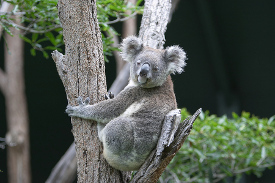 Lone Pine Koala Sanctuary, Brisbane
Lone Pine Koala Sanctuary, BrisbaneLone Pine Koala Sanctuary (the first and oldest of its kind in the world) offers an intimate experience with these sleepy, sweet marsupials that are synonymous with the land Down Under. Not only will you get to see them (130 of them to be precise), but you'll also get to cuddle one of these living teddy bears for free - just watch your children, in case they try to take one home. Less than an hour drive from the Gold Coast, the peaceful reserve makes for a fantastic day trip when you're ready to take a break from the beach.
For more information visit www.koala.net
Best For Bears
Libearty Bear Sanctuary, RomaniaThe idea for Libearty Sanctuary was also born after a kindhearted individual, Cristina Lapis, saw three bears in a cage outside a restaurant. The poor bears were being used to attract customers. She would go on to learn about institutionalised cruelty of bears throughout her country, which prompted her to take action. After years of organising, pleading with authorities and good old fashioned hard work, her dream of creating a sanctuary for mistreated and abused bears in Romania has come to fruition. Libearty is set on 70 hectares of oak and hazel forest in the Carpathian Mountains. Over fifty bears that once lived as dancing sideshow acts, or inside a cage the size of a washing machine, now have free reign in the sanctuary. While this is not your standard 'zoo' experience, you are watching free bears with a new lease on life, in an environment unlike anything they've ever experienced.
For more information on the sanctuary, visiting there and how you can help, check out amp.milioanedeprieteni.org/
Best For Orangutans
 Bukit Lawang, Indonesia
Bukit Lawang, IndonesiaBukit Lawang is home to the famous orangutan rehabilitation centre. Located in rural Sumatra, where the wild river and forest make up the architecture of the landscape, you are stepping into a world completely unlike the one back home. The trees above you are home to these strangely beautiful and bizarre looking primates, along with a host of other forest animals that will have you snapping away a photo-a-minute. The centre first started as a safe haven for orangutans, after they faced near-extinction due to hunting. There are no bars separating you from them, but a fair amount of etiquette needs to be practiced for your safety and their wellbeing and that is just part of the natural experience.
For more information visit www.bukitlawang.com
Best For Elephants
Addo Elephant Park, South AfricaThe Addo Elephant Park offers visitors a chance to observe these incredible mammals in a natural setting without any bars or annoying trainers. In fact the setting is quite the opposite of a regular zoo experience. You are seated in your little car driving through their big open space, rather than the other way around. The park is one of several hot spots along the picturesque Garden Route - a passage of beauty on the South East coast of South Africa. It originally started as a conservation project back in 1931, when only 16 elephants remained in the area. More than eighty years later it has grown into a full-on eco-system that is home to over 500 elephants and a full cast of Africa's finest wildlife.
For more information visit www.sanparks.org







